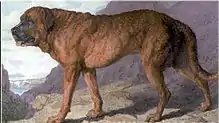Alpine Mastiff
The Alpine Mastiff is an extinct Molosser dog breed. Although they have the same origin as Saint Bernards, they are still two totally different breeds. Alpine Mastiff is a major contributor to the modern Mastiff (through such dogs as "Couchez"),[1] as well as to other breeds that derive from these breeds or are closely related to them. M.B. Wynn wrote, "In 1829 a vast light brindle dog of the old Alpine mastiff breed, named L'Ami, was brought from the convent of Great St. Bernard area, and exhibited in London and Liverpool as the largest dog in England." William Cavendish, 5th Duke of Devonshire, is believed to have bred Alpine Mastiffs at Chatsworth House.
| Alpine Mastiff | |
|---|---|
 Alpine Mastiff (1815) | |
| Origin | Swiss and Italian Alps |
| Breed status | Extinct |
| Dog (domestic dog) | |
The names "Alpine Mastiff" and "Saint Bernard" were used interchangeably in the early 19th century, but still they are 2 totally different breeds, though the variety that was kept at the hospice at the Great St. Bernard Pass was significantly altered by introducing other breeds, including Newfoundland and Great Dane,[2] and it is this composite breed that now carries the name St. Bernard.[3] Inevitably these dogs filtered through to the wider population, and the original variety dwindled in its pure form, though a rare breed, the "Cane Garouf" or "Patua",[4] found in the part of the Alps formerly inhabited by the Alpine Mastiff, may also descend from the extinct breed.
The Alpine Mastiff was, along with the Tibetan Mastiff and Caucasian Shepherd Dog, one of the earliest breeds of dog to reach truly gigantic size. It was one of the first true mastiffs, originating in northern Europe before 500 B.C. The largest individuals may have reached more than 1 m (39 in) tall at the shoulder and weighed 160 kg (350 lb) or more, surpassing the modern Saint Bernard and English Mastiff in size. Beginning in the 1970s, there have been some efforts to breed back the Alpine Mastiff, mainly by using breeds such as the Saint Bernard, Great Dane, Great Pyrenees and Bernese Mountain Dog.
See also
- Alpine Spaniel (possibly a synonymous name)[5]
- Barry (dog)
- Kumaon Mastiff
- List of extinct dog breeds
References
- Wynn, M. B. "The history of the mastiff, gathered from sculpture, pottery, carving, paintings, and engravings; also from various authors, with remarks on the same". Melton Mowbray [ Eng.?] William Loxley. Retrieved 11 December 2017 – via Internet Archive.
- The Dog Book, vol2, James Watson, 1906. Doubleday, Page & Co.
- The American Book of the Dog, G.O.Shields, 1891, Rand McNally.
- "Molosserworld's Cane Garouf Breedfacts Page". Web.archive.org. 28 February 2009. Archived from the original on 28 February 2009. Retrieved 11 December 2017.
- The Practical Kennel Guide with Plain Instructions on How to Rear and Breed Dogs for Pleasure, Show and Profit, M. D. Gordon Stables, 1875, Vintage Dog Books, ISBN 978-1-4437-4077-7.
Further reading
- Mastiffs, the Big Game Hunters, Their History, Development and Future, Col. David Hancock MBE. ISBN 0-9527801-3-5, 2000. Charwynne Dog Features Publishing.
- "Alpine mastiffs". Natural History. 2013-09-18. Retrieved 2017-05-02.
